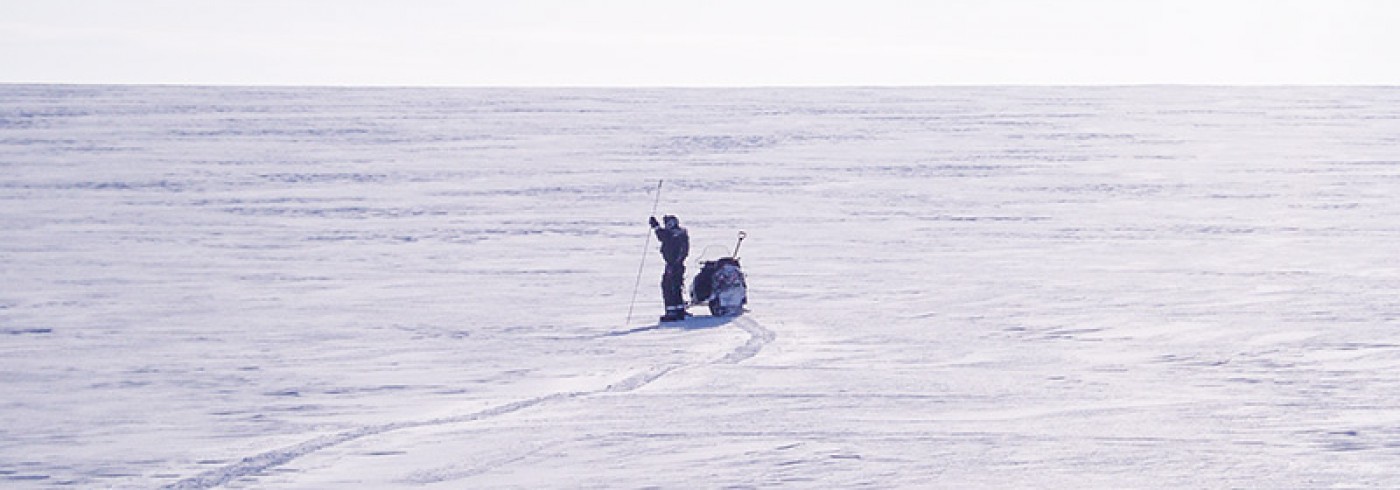Ice dynamical work on Nordenskiöldbreen/ Lomonosovfonna 2009
22 March 2009 - 29 March 2009
Left: Positions of GPS receivers on Nordenskiöldbreen. Right: Map of Spitsbergen, study area marked.
Background
Lomonosovfonna is an ice field extending over 1 000 km2, situated on the eastern part of Spitsbergen. Several outlet glaciers flow from the ice field into the adjacent fjords. One of these is Nordenskiöldbreen, which calves into Billefjorden opposite to the old abandoned coal mine Pyramiden. Nordenskiöldbreen is 25 km long, approximately 5 km wide, and has a maximal ice depth of about 600 m. The glacier is named after the Finnish-Swedish geologist Adolf Erik Nordenskiöld who explored Svalbard during the 1860–1880s. Nordenskiöld and his Swedish and Norwegian colleagues built a station in the vicinity of Billefjorden as a base for their endeavours, and this house is now the oldest building still standing on Svalbard. Since 1997 glaciologists from Uppsala University have been participating in an ongoing ice dynamical/ice coring project on Nordenskiöldbreen and Lomonosovfonna. The project is primarily a collaboration between the Norwegian Polar Institute and the University of Utrecht.
Since 2006 the flow of Nordenskiöldbreen has been closely and continuously observed by 11 fixed GPS receivers placed on aluminium poles along the flow line of the glacier (figure 1). Together with information recorded at a station that logs changes of surface elevation and the temperature of the air and ice, the ice flow record will be used to estimate the ice balance flux of the glacier system. Once the present balance flux is determined, we can use the information in our archives from the ice cores drilled on the ice field to estimate the ice flux back in time. Furthermore, with the prognosis of future change in air temperature and precipitation, we will be able to make a prognosis of future change of the glacier.
Fieldwork in 2009
On March 22nd a small party of two persons from Uppsala and two from Utrecht joined a snowmobile train led by the Norwegian Polar Institute to drive up to Lomonosovfonna. The train of 15 persons included a Swiss-Norwegian-Swedish ice core expedition that aimed to drill an ice core on Lomonosovfonna. The Swedish participant on the drill team was Carmen Vega. An ice core was successfully drilled at this location in 1997, but this time more ice was required in order to carry out a more elaborate analysis. We placed the drill site 5 km south of the earlier drill site to further test if local conditions inf luence the records. The route taken was via De Geerdalen, crossing Tempelfjorden into Gipsdalen up to Lomonosovfonna. The ice core team camped on top of Lomonosovfonna, while the ice dynamical team was located below the glacier in an emergency hut in Brucebyen.
We stayed in the area for 7 days. Weather was in general brisk and blowy, overcast and cold, as weather usually is on Spitsbergen in March. We managed to work on all but two days due to a storm. On this occasion we tried to make a delivery of provisions to the ice core camp, but we had to stop when the hurricane-strength wind gusts downwind of Terrierfjellet managed to tip over our vehicles twice. Our task was to exchange all GPS receivers that we had placed on the glacier the previous year, and download the recorded data. Of the 11 GPS receivers that had been placed out, we found only 7. Two of them could not be reached due to thin snow layers and the risk of driving over crevasses. These were located on the lower part of the glacier. The other two were lost due to too much snow accumulation on the upper part of the glacier where they were placed. When visiting the GPS stations we also measured the positions with portable Trimble receivers, to get a good static motion measured over the annual interval. We further mounted a full Automatic Weather Station in the middle of the glacier in order to obtain the full parameterisation of atmospheric variables. We packed up, and drove home on March 29th. Since our arrival Tempelfjorden had frozen, which made our track home short and fast, and we finally saw the sun.

